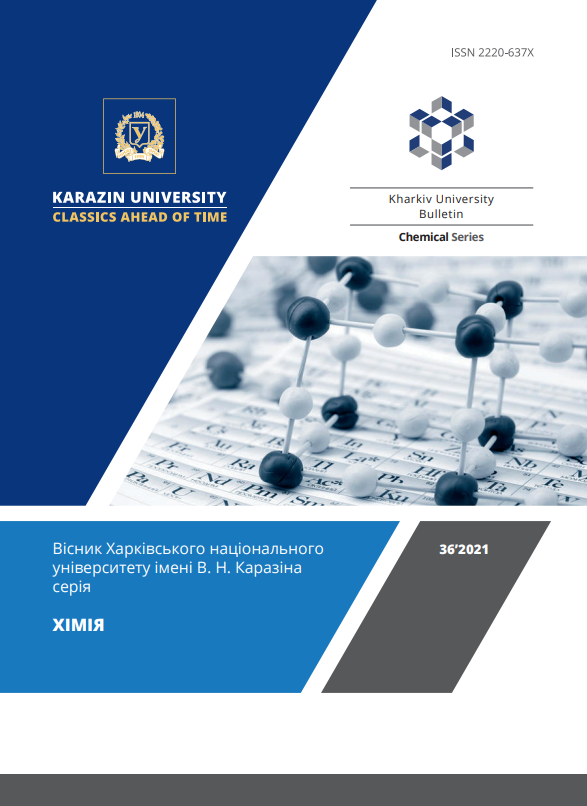Провідність електронних ефектів в молекулі флуоресцеїну: нітро- та аміногрупи у залишку фталевої кислоти
Анотація
Метою цієї роботи є оцінка передачі електронних ефектів між залишком фталевої кислоти та ксантеновою частиною в молекулі флуоресцеїну. Незважаючи на майже ортогональну орієнтацію цих фрагментів, не можна виключити певного впливу замісників у 9-арильному кільці на дисоціацію гідроксильної групи гідроксиксантену. Щоб виявити цей (можливий) ефект, ми заблокували карбоксильну групу шляхом естерифікації. Причиною використання диметилсульфоксиду як розчинника була висока
константа Гаммета, «ро», для фенольної групи. Значення pKa восьми метилових або етилових естерів 3'-, 4'- і 5'-нітро- та амінофлуоресцеїнів визначали в бензоатних і саліцилатних буферних розчинах спектрофотометричним методом. Константи дисоціації катіонних форм нітропохідних визначали в розведеній п-толуолсульфоновій кислоті. Значення pKa збільшуються на 0,2–0,3 одиниці у випадку амінопохідних, тоді як для нітропохідних pKa зменшується на 0,2–0,8. Для замісників у положенні 5' відмічено найменший вплив. Для уточнення впливу алкільної групи були отримані значення pKa метилових та етилових естерів еозину (2,4,5,7-тетрабромфлуоресцеїну). Максимуми поглинання і молярні коефіцієнти поглинання аніонів, а також pKa в ДМСО збігаються в межах довірчого інтервалу.
Завантаження
Посилання
Zhou P., Tang Z., Li P., Liu J. Unraveling the mechanism for tuning the fluorescence of fluorescein derivatives: the role of the conical intersection and nπ* State. J. Phys. Chem. Lett. 2021, 12(28), 6478-6485. https://doi.org/10.1021/acs.jpclett.1c01774
Nowak P. M., Wozniakiewicz M. The acid-base/deprotonation equilibrium can be studied with a micro scale thermophoresis (MST). Molecules 2022, 27(3), 685. https://doi.org/10.3390/molecules27030685
Zdonczyk M., Potaniec B., Skorenski M., Cybinska J. Development of efficient one-pot methods for the synthesis of luminescent dyes and sol–gel hybrid materials. Materials 2022, 15(1), 203. https://doi.org/10.3390/ma15010203
Tamulis A., Tamuliene J., Balevicius M. L., Rinkevicius Z., Tamulis V. Quantum mechanical studies of intensity in electronic spectra of fluorescein dianion and monoanion forms. Structural Chemistry. 2003, 14(6), 643-648. https://doi.org/10.1023/B:STRUC.0000007575.53499.d0
Слюсарева Е. А., Томилин Ф. Н., Сизых А. Г., Танкевич Е. Ю., Кузубов А. А., Овчинников С. Г. Влияние галогензамещения на структуру и электронные спектры флуороновых красителей Оптика спектр. 2012, 112(5), 729-737.
Реутов О.А., Курц А.Л., Бутин К.П. Органическая химия, в 4 частях, часть 1 (4-е издание), М.: БИНОМ. Лаборатория знаний, 567 с.
Chantooni M. K., Kolthoff I. M. Comparison of substituent effects on dissociation and conjugation of phenols with those of carboxylic acids in acetonitrile, N,N-dimethylformamide, and dimethyl sulfoxide. J. Phys. Chem., 1976, 80 (12), 1306-1310. https://doi.org/10.1021/j100553a009
Kolthoff I. M., Chantooni M. K. Calibration of the glass electrode in acetonitrile. Shape of potentiometric titration curves. Dissociation constant of picric acid. J. Amer. Chem. Soc. 1965, 87(20) 44218-4436. https://doi.org/10.1021/ja00948a004
Kolthoff I. M., Chantooni M. K., Bhowmik Jr., and S. Dissociation Constants of Uncharged and Monovalent Cation Acids in Dimethyl Sulfoxide. J. Am. Chem. Soc., 1968, 90 (1) 23-28. https://doi.org/10.1021/ja01003a005
Mchedlov-Petrossyan N.O., Cheipesh T.A., Shekhovtsov S.V., Ushakova E.V., Roshal A.D., Omelchenko I.V. Aminofluoresceins vs fluorescein: Ascertained new unusual features of tautomerism and dissociation of hydroxyxanthene dyes in solution. J. Phys. Chem. A, 2019, 123(41), 8845-8859. https://doi.org/10.1021/acs.jpca.9b05810
Mchedlov-Petrossyan N.O., Cheipesh T.A., Shekhovtsov S.V., Redko A.N.,. Rybachenko V.I, Omelchenko I.V., Shishkin O.V. Ionization and tautomerism of methyl fluorescein and related dyes. Spectrochim. Acta A. 2015, 150, 151-161. http://dx.doi.org/10.1016/j.saa.2015.05.037




